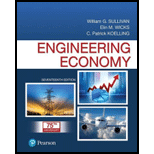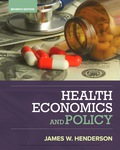
Engineering Economy (17th Edition)
17th Edition
ISBN: 9780134870069
Author: William G. Sullivan, Elin M. Wicks, C. Patrick Koelling
Publisher: PEARSON
expand_more
expand_more
format_list_bulleted
Question
Chapter 12, Problem 12P
(a):
To determine
Calculate the expected present worth.
(b):
To determine
Calculate the probability.
Expert Solution & Answer
Want to see the full answer?
Check out a sample textbook solution
Students have asked these similar questions
Problem 1
Regression Discontinuity
In the beginning of covid, the US government distributed covid stimulus payments. Suppose
you are interested in the effect of receiving the full amount of the first stimulus payment on
the total spending in dollars by single individuals in the month after receiving the payment.
Single individuals with annual income below $75,00 received the full amount of the stimulus
payment.
You decide to use Regression Discontinuity to answer this question. The graph below shows
the RD model.
3150
3100
3050
Total Spending in the month after receiving the stimulus payment
2950
3000
74000
74500
75000
75500
76000
Annual income
a. What is the outcome? (5 points)
b. What is the treatment? (5 points)
C. What is the running variable? (5 points)
d. What is the cutoff? (5 points)
e. Who is in the treatment group and who is in the control group? (10 points)
f. What is the discontinuity in the graph and how do you interpret it? (10 points)
g. Explain a scenario which can…
Problem 2
Difference-in-Difference
In the beginning of 2005, Minnesota increased the sales tax on alcohol. Suppose you are
interested in studying the effect of the increase in sale taxes on alcohol on the number of car
accidents due to drinking in Minnesota. Unlike Minnesota, Wisconsin did not change the
sales tax on alcohol. You decide to use a Difference-in-difference (DID) Model. The numbers
of car accidents in each state at the end of 2004 and 2005 are as follows:
Year
Number of car
accidents in Minnesota
Number of car
accidents in Wisconsin
2004
2000
2500
2005
2500
3500
a. Which state is the treatment state and which state is the control state? (10 points)
b. What is the change in the outcome for the treatment group between 2004 and 2005?
(5 points)
C. Can we interpret the change in the outcome for the treatment group between 2004
and 2005 as the causal effect of the policy on car accidents? Explain your answer. (10
points)
d. What is the change in the outcome for the control…
Environmental Economics
Chapter 12 Solutions
Engineering Economy (17th Edition)
Ch. 12 - Prob. 1PCh. 12 - Prob. 2PCh. 12 - A new snow making machine utilizes technology that...Ch. 12 - Prob. 4PCh. 12 - Prob. 5PCh. 12 - Prob. 6PCh. 12 - Prob. 7PCh. 12 - Prob. 8PCh. 12 - Prob. 9PCh. 12 - Prob. 10P
Ch. 12 - Prob. 11PCh. 12 - Prob. 12PCh. 12 - Prob. 13PCh. 12 - Prob. 14PCh. 12 - Prob. 15PCh. 12 - Prob. 16PCh. 12 - Prob. 17PCh. 12 - Prob. 18PCh. 12 - Prob. 19PCh. 12 - Prob. 20PCh. 12 - Prob. 21PCh. 12 - Prob. 22PCh. 12 - If the interest rate is 8% per year, what decision...Ch. 12 - Prob. 24PCh. 12 - Prob. 25PCh. 12 - Prob. 26SE
Knowledge Booster
Similar questions
- Environmental Economicsarrow_forwardEnvironmental Economicsarrow_forward1. The current price for a barrel of oil is $28. Assume the marginal extraction cost per barrel is $8 and the interest rate is 4 percent per year. a. According to the standard Hotelling model for a nonrenewable resource, what is the forecasted price for next year? b. How would your forecast change (qualitatively) if the demand for oil increased before next year?arrow_forward
- • What are the 5 positive and 5 negative attitudes a salesperson has? What are the best way to improve those negative attitudes? • What is the another concise definition of Salesmanship? • As a Watson's salesperson in the Philippines what are they're: - earning opportunities? - chances of promotion and career growth? - rewards and awards? - incentives and fringe benefits? - employment requirements?arrow_forwardWhere in the Victoria, BC is the most logging occurring? Include relative and absolute locationsarrow_forwardIn Foresty , What do most clear cut locations have in common with each other? Do they occur along the shorelines of lakes and rivers? Near major highways? Are they near cities or far from people?arrow_forward
- How sustainable is the forestry industry in BC in your opinion? Not at all, somewhat, very and explain your reasoning.arrow_forwardIn a paragraph, no bullet, points please answer the question and follow the instructions. Give only the solution: Use the Feynman technique throughout. Assume that you’re explaining the answer to someone who doesn’t know the topic at all. 6.Draw a standard Commercial Bank Balance Sheet and briefly explain each of the main components.arrow_forwardC1 The following model can be used to study whether campaign expenditures affect election outcomes: voteA = 0 + B₁ log(expendA) + ẞ₂ log(expendB) + ẞ3 prtystrA + u, where voteA is the percentage of the vote received by Candidate A, expendA and expend are campaign expenditures by Candidates A and B, and prtystrA is a measure of party strength for Candidate A (the percentage of the most recent presidential vote that went to A's party). == (i) (ii) (iii) (iv) What is the interpretation of B₁? In terms of the parameters, state the null hypothesis that a 1% increase in A's expenditures is offset by a 1% increase in B's expenditures. Estimate the given model using the data in VOTE1.DTA and report the results in usual form. Do A's expenditures affect the outcome? What about B's expenditures? Can you use these results to test the hypothesis in part (ii)? Estimate a model that directly gives the t statistic for testing the hypothesis in part (ii). What do you conclude? (Use a two-sided…arrow_forward
- In a paragraph, no bullet, points please answer the question and follow the instructions. Give only the solution: Use the Feynman technique throughout. Assume that you’re explaining the answer to someone who doesn’t know the topic at all. 10. What is Tinbergen’s constraint? Explain its importance in regard to US monetary policy.arrow_forwardIn a paragraph, no bullet, points please answer the question and follow the instructions. Give only the solution: Use the Feynman technique throughout. Assume that you’re explaining the answer to someone who doesn’t know the topic at all. 8. How does monetary policy supposedly translate into changes in AD?arrow_forwardIn a paragraph, no bullet, points please answer the question and follow the instructions. Give only the solution: Use the Feynman technique throughout. Assume that you’re explaining the answer to someone who doesn’t know the topic at all. 2. Carefully explain either Keynes’ “cookie jar” motive for holding money or the “saw-toothed model’s” motive for holding a safety stock.arrow_forward
arrow_back_ios
SEE MORE QUESTIONS
arrow_forward_ios
Recommended textbooks for you
 Managerial Economics: Applications, Strategies an...EconomicsISBN:9781305506381Author:James R. McGuigan, R. Charles Moyer, Frederick H.deB. HarrisPublisher:Cengage Learning
Managerial Economics: Applications, Strategies an...EconomicsISBN:9781305506381Author:James R. McGuigan, R. Charles Moyer, Frederick H.deB. HarrisPublisher:Cengage Learning
 Managerial Economics: A Problem Solving ApproachEconomicsISBN:9781337106665Author:Luke M. Froeb, Brian T. McCann, Michael R. Ward, Mike ShorPublisher:Cengage Learning
Managerial Economics: A Problem Solving ApproachEconomicsISBN:9781337106665Author:Luke M. Froeb, Brian T. McCann, Michael R. Ward, Mike ShorPublisher:Cengage Learning



Managerial Economics: Applications, Strategies an...
Economics
ISBN:9781305506381
Author:James R. McGuigan, R. Charles Moyer, Frederick H.deB. Harris
Publisher:Cengage Learning


Managerial Economics: A Problem Solving Approach
Economics
ISBN:9781337106665
Author:Luke M. Froeb, Brian T. McCann, Michael R. Ward, Mike Shor
Publisher:Cengage Learning


